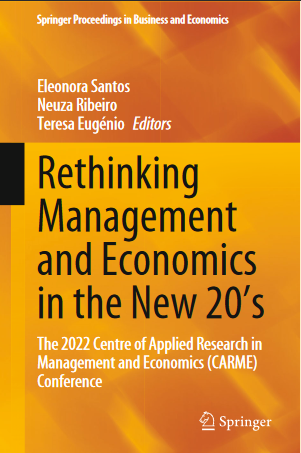he companies’ business activities may be subject to different market risks, such as interest rate, exchange rate volatility and commodity prices. Companies can adopt risk management practices to isolate the volatility effects of financial exposures, such as impacts on cash flows and future losses or gains from changes in interest rates and changes in exchange rates (Chang et al., 2016), and financial derivatives are considered as a tool to mitigate the financial risks faced by corporations (Guay & Kothari, 2003). In order to adequately reflect the use of financial instruments in the A. C. de Paula Leite · L. M. Pimentel (B) University of Coimbra, FEUC, Coimbra, Portugal e-mail: liliana.pimentel@fe.uc.pt © The Author(s), under exclusive license to Springer Nature Singapore Pte Ltd. 2023 E. Santos et al. (eds.), Rethinking Management and Economics in the New 20’s, Springer Proceedings in Business and Economics, https://doi.org/10.1007/978-981-19-8485-3_1 3 4 A. C. de Paula Leite and L. M. Pimentel risk activities of companies, hedge accounting proposes some guidelines to repre- sent in the financial statements the accounting effects of entities that choose to use financial instruments to manage their exposures arising from market and financial risks (IFRS 9.6 1.1). The adoption of hedge accounting is voluntary in the entity’s risk management. If the entity decides to apply, measurement of financial instruments under hedge accounting standards is permitted when all the specific requirements described in the standard are met. The application of derivative instruments for corporate risk management has shown substantial growth in recent years and, as a result, there is an increasing need to improve the regulation of their accounting treatment and disclosure (Camp- bell et al., 2019; Panaretou et al., 2013). Additionally, accounting regulators are concerned with providing solutions that facilitate the adoption of rules by entities and that these rules can be understood from the point of view of investors and other users. In historical context, in 2001 the International Accounting Standard Board (IASB) adopted the International Accounting Standard (IAS) 39 Financial Instruments: Recognition and Measurement, published by the International Accounting Stan- dards Committee (IASC) in 1999. Originally, IAS 39 was first published in 1998 and superseded some chapters of IAS 25 Accounting for Investments, issued in March 1986. IAS 25 was not a hedge accounting standard, but an investment standard, so there were no specific requirements for hedge accounting until publication of IAS 39. After the publication of the standard, IAS 39 was strongly criticized for its high complexity and restrictive rules, so that to simplify hedge accounting, the IASB started in 2009 a project to replace IAS 39 with IFRS 9 (Müller, 2020). In order to improve accounting standards for users’ best practices, the IASB divided its IAS 39 replacement project into three main phases and, at the end of each phase, issued the chapter of the International Financial Reporting Standard (IFRS) 9 which replaced the corresponding requirements in IAS 39. One of the goals of adopting a more comprehensive IFRS regime in this area has been to increase trans- parency in the disclosure of derivatives and their use for risk management purposes (Panaretou et al., 2013). After publication of the full version in 2014, IFRS 9 allows an entity to choose as an accounting policy to apply the hedge accounting requirements of IFRS 9 or continue to apply the hedge accounting requirements of IAS 39 in accordance with paragraph 7.2.21 paragraph 6.1.3 of IFRS 9. This option is valid for companies until the IASB finalizes the IFRS 9 macro hedging project (IFRS 9, BC6.104) (Fig. 1). The purpose of hedge accounting is to represent, in the financial statements, the effect of the risk management activities of an entity that uses financial instruments to manage exposures arising from specific risks, and these instruments may influence the result or, also, the other comprehensive results (IFRS 9.6. 1.1). Hedge accounting is based on offsetting gains and losses on the hedging instrument and hedged object, so the effect of market risk on the value of the hedging instrument and hedged item impacts the effectiveness of the hedge (IFRS 9, B6. 4.7
چکیده فارسی
فعالیتهای تجاری شرکتها ممکن است در معرض ریسکهای مختلف بازار مانند نرخ بهره، نوسانات نرخ ارز و قیمتهای کالا باشد. شرکتها میتوانند شیوههای مدیریت ریسک را برای جداسازی اثرات نوسانات مواجهههای مالی، مانند تأثیرات بر جریانهای نقدی و زیانها یا سودهای آتی ناشی از تغییرات در نرخهای بهره و تغییرات نرخ ارز اتخاذ کنند (چانگ و همکاران، 2016)، و مشتقات مالی در نظر گرفته میشوند. به عنوان ابزاری برای کاهش ریسک های مالی شرکت ها (گوای و کوتاری، 2003). به منظور انعکاس کافی استفاده از ابزارهای مالی در A. C. de Paula Leite · L. M. Pimentel (B) دانشگاه کویمبرا، FEUC، کویمبرا، پرتغال پست الکترونیکی: liliana.pimentel@fe.uc.pt © نویسنده(های) ، تحت مجوز انحصاری Springer Nature Singapore Pte Ltd. 2023 E. Santos et al. (ویرایشگران)، بازاندیشی مدیریت و اقتصاد در دهه 20 جدید، مجموعه مقالات Springer در تجارت و اقتصاد، https://doi.org/10.1007/978-981-19-8485-3_1 3 4 A. C. de Paula Leite and L. M. Pimentel risk فعالیت های شرکت ها، حسابداری پوششی دستورالعمل هایی را پیشنهاد می کند تا در صورت های مالی اثرات حسابداری واحدهایی را که استفاده از ابزارهای مالی را برای مدیریت مواجهه های ناشی از ریسک های بازار و مالی انتخاب می کنند، در صورت های مالی ارائه دهد (IFRS 9.6 1.1). اتخاذ حسابداری پوششی در مدیریت ریسک واحد تجاری داوطلبانه است. در صورتی که واحد تجاری تصمیم به اعمال کند، اندازهگیری ابزارهای مالی تحت استانداردهای حسابداری پوششی زمانی مجاز است که تمام الزامات خاص توضیح داده شده در استاندارد برآورده شود. استفاده از ابزارهای مشتقه برای مدیریت ریسک شرکت رشد قابل توجهی را در سال های اخیر نشان داده است و در نتیجه، نیاز روزافزونی به بهبود مقررات رفتار حسابداری و افشای آنها وجود دارد (کمپبل و همکاران، 2019؛ پانارتو و همکاران .، 2013). علاوه بر این، تنظیم کننده های حسابداری به ارائه راه حل هایی می پردازند که پذیرش قوانین توسط واحدهای تجاری را تسهیل می کند و این قوانین را می توان از دیدگاه سرمایه گذاران و سایر کاربران درک کرد. در زمینه تاریخی، در سال 2001، هیئت استانداردهای حسابداری بینالمللی (IASB) استاندارد بینالمللی حسابداری (IAS) 39 ابزارهای مالی: شناسایی و اندازهگیری را که توسط کمیته استانداردهای حسابداری بینالمللی (IASC) در سال 1999 منتشر شد، تصویب کرد. اولین بار در سال 1998 منتشر شد و جایگزین برخی از فصول استاندارد حسابداری 25 حسابداری سرمایه گذاری، صادر شده در مارس 1986 شد. انتشار استاندارد، IAS 39 به دلیل پیچیدگی بالا و قوانین محدودکننده آن به شدت مورد انتقاد قرار گرفت، به طوری که برای ساده کردن حسابداری پوششی، IASB در سال 2009 پروژه ای را برای جایگزینی IAS 39 با IFRS 9 آغاز کرد (مولر، 2020). به منظور بهبود استانداردهای حسابداری برای بهترین شیوه های کاربران، IASB پروژه جایگزینی IAS 39 خود را به سه فاز اصلی تقسیم کرد و در پایان هر مرحله، فصل استاندارد بین المللی گزارشگری مالی (IFRS) 9 را منتشر کرد که جایگزین استاندارد مربوطه شد. الزامات استاندارد استاندارد حسابداری 39. یکی از اهداف اتخاذ یک رژیم جامع IFRS در این زمینه، افزایش شفافیت در افشای اوراق مشتقه و استفاده از آنها برای اهداف مدیریت ریسک بوده است (Panaretou et al., 2013). پس از انتشار نسخه کامل در سال 2014، IFRS 9 به واحد تجاری اجازه می دهد تا به عنوان یک رویه حسابداری برای اعمال الزامات حسابداری پوششی IFRS 9 یا ادامه اعمال الزامات حسابداری پوششی استاندارد استاندارد حسابداری 39 مطابق با بند 7.2.21 بند 6.1، انتخاب کند. 3 از IFRS 9. این گزینه تا زمانی که IASB پروژه پوشش ریسک کلان IFRS 9 (IFRS 9, BC6.104) را نهایی نکند برای شرکت ها معتبر است (شکل 1). هدف از حسابداری پوششی این است که در صورت های مالی، اثر فعالیت های مدیریت ریسک واحد تجاری را که از ابزارهای مالی برای مدیریت مواجهه های ناشی از ریسک های خاص استفاده می کند، نشان دهد و این ابزارها ممکن است بر نتیجه یا سایر جامع ها تأثیر بگذارد. نتایج (IFRS 9.6. 1.1). حسابداری پوششی مبتنی بر خنثی کردن سود و زیان ابزار پوششی و شی پوششدهی شده است، بنابراین تأثیر ریسک بازار بر ارزش ابزار پوششدهی و اقلام پوششدار بر اثربخشی پوشش تأثیر میگذارد (IFRS 9, B6. 4.7
ادامه ...
بستن ...
Editors
Eleonora Santos
CARME – Edifício C
School of Technology and Management
Polytechnic Institute of Leiria
Centre of Applied Research in Management
and Economics
Leiria, Portugal
Teresa Eugénio
CARME – Edifício C
School of Technology and Management
Polytechnic Institute of Leiria
Centre of Applied Research in Management
and Economics
Leiria, Portugal
Neuza Ribeiro
CARME – Edifício C
School of Technology and Management
Polytechnic Institute of Leiria
Leiria, Portugal
ISSN 2198-7246 ISSN 2198-7254 (electronic)
Springer Proceedings in Business and Economics
ISBN 978-981-19-8484-6 ISBN 978-981-19-8485-3 (eBook)
https://doi.org/10.1007/978-981-19-8485-3
© The Editor(s) (if applicable) and The Author(s), under exclusive license to Springer Nature
Singapore Pte Ltd. 2023
This work is subject to copyright. All rights are solely and exclusively licensed by the Publisher, whether
the whole or part of the material is concerned, specifically the rights of translation, reprinting, reuse
of illustrations, recitation, broadcasting, reproduction on microfilms or in any other physical way, and
transmission or information storage and retrieval, electronic adaptation, computer software, or by similar
or dissimilar methodology now known or hereafter developed.
The use of general descriptive names, registered names, trademarks, service marks, etc. in this publication
does not imply, even in the absence of a specific statement, that such names are exempt from the relevant
protective laws and regulations and therefore free for general use.
The publisher, the authors, and the editors are safe to assume that the advice and information in this book
are believed to be true and accurate at the date of publication. Neither the publisher nor the authors or
the editors give a warranty, expressed or implied, with respect to the material contained herein or for any
errors or omissions that may have been made. The publisher remains neutral with regard to jurisdictional
claims in published maps and institutional affiliations.
This Springer imprint is published by the registered company Springer Nature Singapore Pte Ltd.
The registered company address is: 152 Beach Road, #21-01/04 Gateway East, Singapore 189721,
Singapor
ادامه ...
بستن ...










